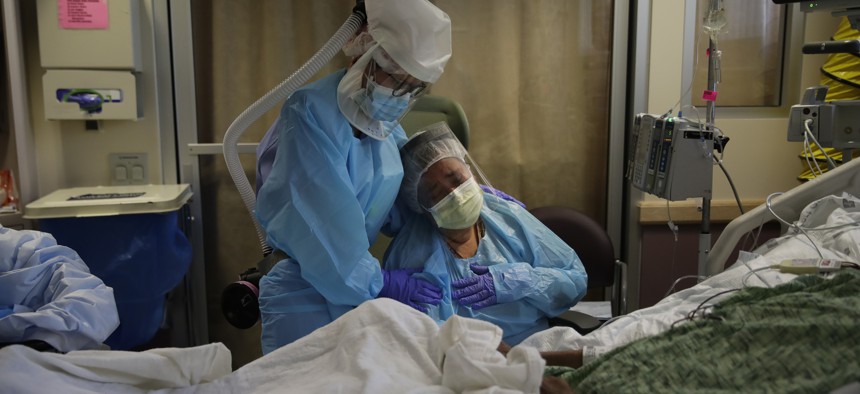Nursing Home Covid-19 Infections Surge in States Seeing Uptick in Cases

Romelia Navarro, right, is comforted by nurse Michele Younkin as she weeps while sitting at the bedside of her dying husband, Antonio, in St. Jude Medical Center's COVID-19 unit in Fullerton, Calif., July 31, 2020. AP Photo/Jae C. Hong
A new report has found that the number of cases reported weekly in nursing homes has surpassed its all-time high, with 78% of cases occurring in Sun Belt states.
The number of Covid-19 cases reported in U.S. nursing homes have reached an all-time high, driven in part by the rapid surge of new infections across Sun Belt states, according to a new report.
The number of cases reported in nursing homes rose to 9,715 during the week of July 26, surpassing the previous peak of 9,421 cases reported the week of May 31, according to the American Health Care Association and National Center for Assisted Living. The organization analyzed federal data on the spread of the coronavirus in nursing homes and said the increase of cases in nursing homes and assisted living facilities was a result of widespread spikes in the Sunbelt region, which includes states such as Texas, Arizona, California and Florida. Seventy-eight percent of new cases in nursing homes occurred in Sun Belt states in the last week of July, the report found.
Nursing homes are particularly vulnerable to coronavirus outbreaks because the older residents who live there often live in close quarters and may have underlying health conditions that put them at greater risk of death if they become infected.
A lack of rapid coronavirus testing and shortages of personal protective equipment like N95 masks at nursing homes and long-term care facilities has exacerbated the problem, according to Mark Parkinson, President and CEO of the American Health Care Association and National Center for Assisted Living.
“This is especially troubling since many nursing homes and other long-term care facilities are still unable to acquire the personal protective equipment and testing they need to fully combat this virus,” Parkinson said.
The number of coronavirus-related deaths that occurred in U.S. nursing homes has declined since the peak in May, from 3,130 deaths a week to 1,706 deaths the week of July 26, according to the American Health Care Association and National Center for Assisted Living report. But the number of deaths began increasing again at the end of July after having plateaued for several weeks.
In total, more than 402,000 people have been infected at some 17,000 nursing homes and long-term care facilities, the New York Times reported last week.
Yet widespread testing has remained elusive in many states. Last month, only seven states—Connecticut, Maryland, Louisiana, New Hampshire, New Mexico and New York — had ongoing, required testing of residents, staff or both.
The Centers for Medicare and Medicaid Services announced efforts at the end of July to control and reduce outbreaks in nursing home facilities. About 15,000 rapid point-of-care diagnostic testing devices will be distributed to nursing homes over the next few months. The first federal Task Force Strike Teams, which are meant to provide technical assistance and education at nursing homes experiencing outbreaks, deployed to 18 facilities in Illinois, Florida, Louisiana, Ohio, Pennsylvania and Texas between July 18 and July 20.
To control outbreaks, some state and local governments have increasingly begun to deploy strike teams to help get the virus under control when it emerges in a nursing home or assisted living facility.
Even in places where testing occurs on a regular basis, there are still complaints that it is taking too long to get results. A June survey of nursing home staff by the American Health Care Association and National Center for Assisted Living found 63% said it took between two to four days and 24% said it took five days or more to get results.
“What we need – now more than ever – is for our government leaders and lab companies from the private sector to work together to find a solution to prioritize and expedite the processing of tests for nursing home residents and caregivers,” Parkinson said.
Andrea Noble is a staff correspondent with Route Fifty.
NEXT STORY: One County Shuts Down Testing Sites After Inspection Finds 17,000 Tests Might Have Been Inaccurate





